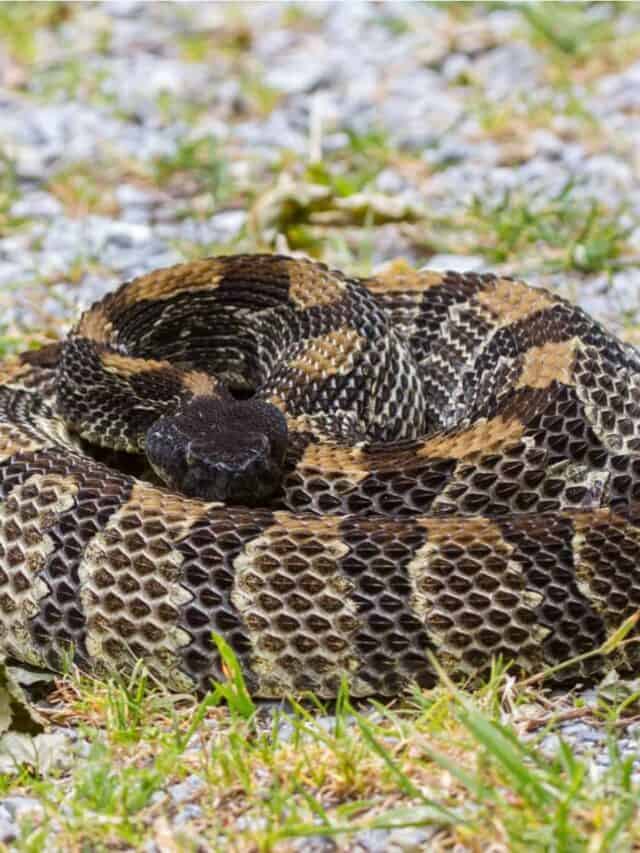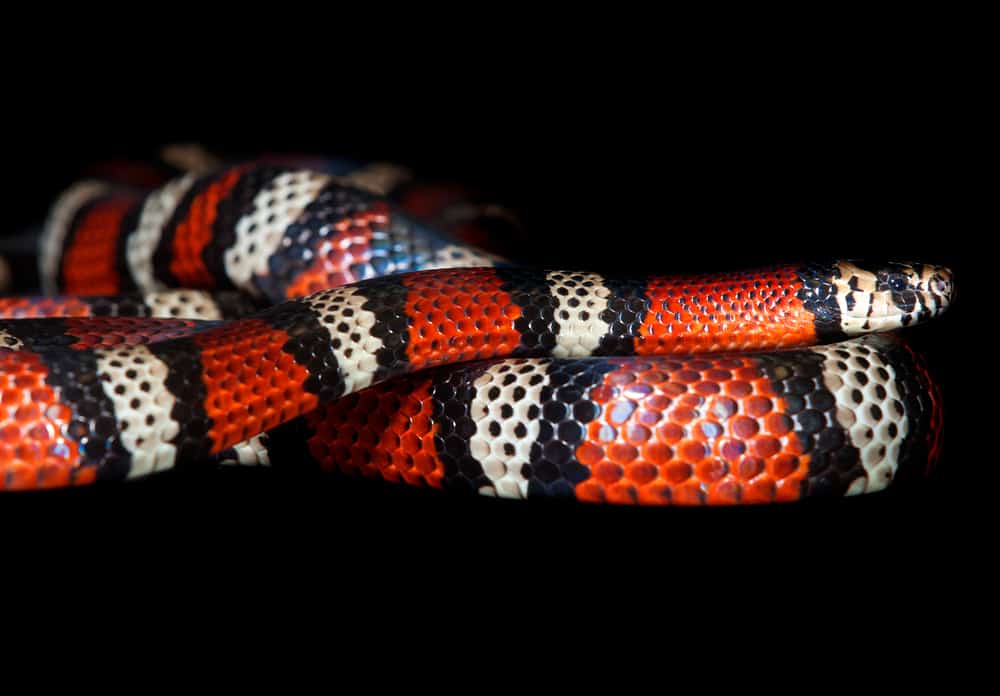With the exception of Alaska and Hawaii, every state in America is home to at least a few snake species. Some of those snakes live semi-aquatic lives in rivers and lakes, while others spend their days staying cool in the desert sands. Here, we’ll discover a few of the snakes that live in America’s forests. We’ll start with the venomous species before moving on to a few of the more ubiquitous snakes that live in America’s forests.
Keep reading to learn more about seven incredible snakes living in the forests of America!
1. Timber Rattlesnake

Timber rattlesnakes in America’s forests aren’t quite as big as eastern diamondback rattlesnakes, but they’re pretty close. These venomous rattlers grow up to six feet long, with typically heavy pit viper bodies. Aside from their rattles and broad, leaf-shaped heads, their most distinguishing feature is their pattern. Timber rattlesnakes are pale tan, with hexagonal bands of darker scales running down their bodies like thin stripes.
These snakes have large, hinged fangs at the front of their mouths. When extended, the fangs are used to deliver neurotoxic venom from large venom glands located just behind their eyes. As pit vipers, timber rattlers also have heat-sensing pits and cat-like eyes. Their main prey is small mammals, including squirrels, mice, rats, and rabbits.
2. Cottonmouth

Also known as water moccasins, these snakes that live in America’s forests grow up to four feet long. Cottonmouths have heavy bodies and wide heads, and their mouths hide a secret weapon. When cottonmouths coil up in their ‘threat’ display, they open their mouths wide, displaying a cottony white interior. This snowy mouth is thought to scare would-be predators—it certainly works to warn humans off.
Cottonmouths have potent venom; any bite necessitates immediate medical attention. Luckily, as with all venomous snakes in America, with prompt medical care, chances of death are very slim. These snakes spend a lot of time either in or near the water. They hunt just about everything, including snakes, lizards, small mammals, alligators, turtles, and even fish.
3. Copperhead

Like the timber rattlesnake and cottonmouth, the copperhead is one of the venomous snakes that live in America’s forests. These snakes grow up to 40 inches long and have heavy bodies with relatively small heads. All copperheads have a base tan color, with a copper-colored head. Their unique pattern is made up of medium to dark brown hourglass markings spaced across their bodies like stripes.
Copperheads are responsible for many bites in America every year, but their bites rarely lead to serious complications. They like to hide under out-buildings, building debris, piles of vegetation, and bushes. These snakes eat anything they can catch, which generally includes birds, snakes, lizards, small mammals, and even insects.
4. Milk Snake

Guillermo Ossa/Shutterstock.com
Technically, milk snakes that live in America’s forests are a type of kingsnake. These non-venomous slitherers grow up to six feet long, though most top out around four feet. They have slim bodies designed for both climbing trees and slithering through the grass. Milk snakes’ primary color is red, punctuated by cream-colored bands bordered by thinner black bands. Unfortunately, they bear a superficial resemblance to coral snakes and are consequently often killed by fearful humans.
Milk snakes are nocturnal hunters that primarily eat mice, shrews, and moles. But, never ones to pass up a meal, they also hunt lizards, snakes, insects, and even birds and fish. Lacking venom, they pose no threat to humans.
5. Mud Snake

Jason Patrick Ross/Shutterstock.com
Mud snakes that live in America’s forests typically grow up to five feet long. They have medium-heavy bodies with narrow heads and short snouts. Their most distinguishing feature is certainly their coloring, which shades towards true black on the back and sides. However, the belly, and parts of the sides, have bright orange to red colors. When threatened, these snakes coil to expose their brightly colored undersides.
Mud snakes like to hunt in the dark, particularly in sources of fresh water, like rivers and lakes. They primarily eat amphibians, like toads, frogs, and salamanders. These snakes lack venom and pose no threat to humans.
6. Garter Snake

Natalia Kuzmina/Shutterstock.com
Garter snakes that live in America’s forests are very well known to many people. These snakes are just as common in the forests of the United States as they are in people’s backyards. Garter snakes are slim, with heads slightly larger than their bodies, and grow up to four feet long. There are many variations in their coloring. But, in general, they all have dark bodies with thin, light stripes running from head to tail.
Garter snakes are small and non-venomous, which means they’re pretty restricted in the type of prey they can hunt. These snakes eat earthworms, insects, tadpoles, and baby rodents.
7. Gopher Snake

rawaccess/Shutterstock.com
Gopher snakes in America’s forests are ubiquitous. They grow up to nine feet long and, unfortunately for them, bear a striking resemblance to rattlesnakes. Unlike rattlesnakes, gopher snakes have round pupils, narrow heads, and no rattles. They’re non-venomous and have proven valuable to human society as controls on rodent populations.
Gopher snakes mainly eat mice, rats, squirrels, rabbits, and other small mammals. They’re typically tan, with dark brown blotches, and a single brown bar across their face. They pose no threat to humans but will bite in self-defense if necessary.
The post Discover 7 Snakes That Live in America’s Forests appeared first on AZ Animals.
from Animal News, Facts, Rankings, and More! - AZ Animals https://ift.tt/wxGk6RD